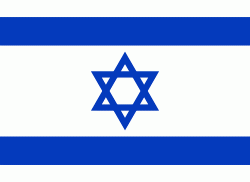Beit She'an (Bet She’an)
Beit She'an (בֵּית שְׁאָן '), also Beth-shean, formerly Beisan''' (بيسان ), is a town in the Northern District of Israel. The town lies at the Beit She'an Valley about 120 m (394 feet) below sea level.
Beit She'an is believed to be one of the oldest cities in the region. It has played an important role in history due to its geographical location at the junction of the Jordan River Valley and the Jezreel Valley. The town's ancient tell contains remains beginning in the Chalcolithic period. It served as an Egyptian administrative center during the Late Bronze Age. During the Hellenistic period, the settlement was known as Scythopolis (Ancient Greek: Σκυθόπολις). After the region came under Roman rule, Scythopolis gained imperial free status and was the leading city of the Decapolis. Later, under Byzantine rule, it served as the capital of Palaestina Secunda. Following the Arab conquest of the Levant, the city lost its prominence.
The population of the town was completely changed from 1948 to 1950. It had been entirely Muslim and Christian, designated to be part of the Jewish state in the 1947 United Nations Partition Plan for Palestine, and was captured by the Haganah in May 1948. The battle over the town during Operation Gideon caused most of its inhabitants to flee, and the remainder were expelled. The town was then resettled exclusively by Jewish immigrants.
Today, Beit She'an serves as a regional centre for the towns in the Beit She'an Valley. The ancient city ruins are now protected within the Beit She'an National Park.
Beit She'an's location has always been strategically significant, due to its position at the junction of the Jordan River Valley and the Jezreel Valley, essentially controlling access from Jordan and the inland to the coast, as well as from Jerusalem and Jericho to the Galilee.
Beit She'an is situated on Highway 90, the north–south road which runs the length of Israel. The city stretches over an area of 7 square kilometers with a substantial national park in the north of the city. Beit She'an has a population of 20,000.
Today the town is under the administration of the Emek HaMa'ayanot Regional Council.
Beit She'an is believed to be one of the oldest cities in the region. It has played an important role in history due to its geographical location at the junction of the Jordan River Valley and the Jezreel Valley. The town's ancient tell contains remains beginning in the Chalcolithic period. It served as an Egyptian administrative center during the Late Bronze Age. During the Hellenistic period, the settlement was known as Scythopolis (Ancient Greek: Σκυθόπολις). After the region came under Roman rule, Scythopolis gained imperial free status and was the leading city of the Decapolis. Later, under Byzantine rule, it served as the capital of Palaestina Secunda. Following the Arab conquest of the Levant, the city lost its prominence.
The population of the town was completely changed from 1948 to 1950. It had been entirely Muslim and Christian, designated to be part of the Jewish state in the 1947 United Nations Partition Plan for Palestine, and was captured by the Haganah in May 1948. The battle over the town during Operation Gideon caused most of its inhabitants to flee, and the remainder were expelled. The town was then resettled exclusively by Jewish immigrants.
Today, Beit She'an serves as a regional centre for the towns in the Beit She'an Valley. The ancient city ruins are now protected within the Beit She'an National Park.
Beit She'an's location has always been strategically significant, due to its position at the junction of the Jordan River Valley and the Jezreel Valley, essentially controlling access from Jordan and the inland to the coast, as well as from Jerusalem and Jericho to the Galilee.
Beit She'an is situated on Highway 90, the north–south road which runs the length of Israel. The city stretches over an area of 7 square kilometers with a substantial national park in the north of the city. Beit She'an has a population of 20,000.
Today the town is under the administration of the Emek HaMa'ayanot Regional Council.
Map - Beit She'an (Bet She’an)
Map
Country - Israel
 |
 |
| Flag of Israel | |
The Southern Levant, of which modern Israel forms a part, is on the land corridor used by hominins to emerge from Africa and has some of the first signs of human habitation. In ancient history, it was where Canaanite and later Israelite civilizations developed, and where the kingdoms of Israel and Judah emerged, before falling, respectively, to the Neo-Assyrian Empire and Neo-Babylonian Empire. During the classical era, the region was ruled by the Achaemenid, Macedonian, Ptolemaic and Seleucid empires. The Maccabean Revolt gave rise to the Hasmonean kingdom, before the Roman Republic took control a century later. The subsequent Jewish–Roman wars resulted in widespread destruction and displacement across Judea. Under Byzantine rule, Christians replaced Jews as the majority. From the 7th century, Muslim rule was established under the Rashidun, Umayyad, Abbasid and Fatimid caliphates. In the 11th century, the First Crusade asserted European Christian rule under the Crusader states. For the next two centuries, the region saw continuous wars between the Crusaders and the Ayyubids, ending when the Crusaders lost their last territorial possessions to the Mamluk Sultanate, which ceded the territory to the Ottoman Empire at the onset of the 16th century.
Currency / Language
| ISO | Currency | Symbol | Significant figures |
|---|---|---|---|
| ILS | Israeli new shekel | ₪ | 2 |
| ISO | Language |
|---|---|
| AR | Arabic language |
| EN | English language |
| HE | Hebrew language |















